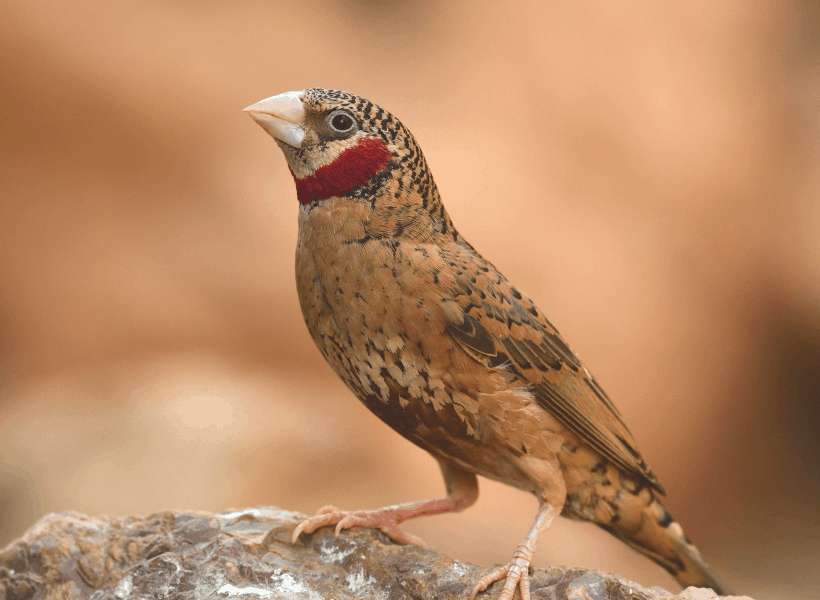Sometimes where finch names come from can be a bit of a mystery but in the case of the Cut throat Finch, there’s no doubt at all. That bright red slash across the male bird’s neck is a complete giveaway as to the inspiration for their name! The Cut-throat is one of the two members of the Amadina genus of the Estrildid finch family and a relatively easy bird to find in captivity.
Meet the Cut-throat
The Cut throat finch (Amadina fasciata) is also known as the Cut throat Weaver and the Ribbon Finch. It is an African finch that has a wide natural distribution ranging from Senegal and Gambia to Somalia in the east and down to Mozambique and Botswana. Here they live in arid areas of savannah, thorn brush scrub as well as semi-desert areas and some cultivated areas.
These birds are around 5 inches in size and as mentioned, they can be sexed by the male bird having a bright red slash across his throat. The birds are generally a sandy brown colour with black markings, a creamy white chin and cheeks as well as a chestnut breast. Their legs and beaks are pale pink colour and the juvenile birds look like a faded version of their parents.


Variations
As well as the normal Cut throat finch with its distinctive red band, there are also a number of variations, or mutations. These include:
- Isabel – creamy white where sandy coloured or chestnut brown, black markings become dark grey (genetics: autosomnal recessive)
- White/Ino – bird is totally white apart from the red throat band on the make bird
- Yellow-throated or orange banded – where the red is replaced by a yellow or orange colour (genetics: autosomal recessive)
In captivity
Cut throats have a varied reputation in captivity with experienced breeders having no luck with them yet others finding they breed easily and freely.
They do have a reputation for being aggressive particularly during breeding season and for this reason, are often said to be unsuitable to live with smaller birds such as waxbills but okay with larger birds such as canaries. They have been known to interfere with other bird’s nests and even toss out eggs or young but not all birds do this.

Their diet is a standard finch diet – good quality finch seed, millet, green foods as well as some fruit such as apples, pears and oranges. They will also eat live food with mealworms, termites and ant pupae being among popular options.
The species is also known for egg binding problems so a constant source of calcium along with a good diet is a good way to help avoid this problem as well as only breeding in warmer months and preventing hens from breeding until at least twelve months old.
Breeding
These birds are of the same family as the Red headed finch so can hybridise with them. To avoid this possibility, the birds should not be kept in the same enclosure.
In the wild, the breeding season of the bird is dictated by the climate of the area. As mentioned, in the UK warmer months are the best time to breed due to egg binding issues. The cock bird will court the female by singing to her and fluffing himself up in an impressive way. She will quiver her tail to confirm mating.
The pair will then use either a covered nest box or make their own nest using a range of coarse materials including grass stems, millet, coconut fibre and even shredded paper. Feathers will also be added to the nest. They may also use the abandoned nests of other birds, even larger species. It is advisable to leave the birds alone while nesting as if the nest is checked, they may abandon it.
The hen will lay 3-6 eggs that are incubated for 12-13 days. The chicks will fledge at around 21-23 days old and will be fully independent from the parents by the six-week mark.
Keeping the Cut throat finch
Personally, I’ve never had much luck with the Cut throat finch. They are lively and interesting birds to keep and I haven’t really seen the aggressive side of their character in a large mixed flight. But I have seen the egg binding problem and lost both hens to it, despite being well aware of the potential the second time around. One moment she was fine, the next not. So while they are definitely a species to enjoy, watch them carefully around breeding time.

1
1.5
0.5
what temperatures are ok for the cutthroats to live in. i live in Utah and our temperatures change a lot during the fall and spring days. what is too low of a temperature for a day in an aviary. they can go into a 70F house any time but can also go into the aviary? your thoughts?
Hi Ed! With any bird, I always take a look at the day and night time temperatures and conditions where they are originally from for an idea. So Cutthroats are African birds, central African mainly so warm temperatures. That makes me think the need shelter in the winter and maybe somewhere to shelter at night in spring and autumn. A quick temperature comparison between your averages and these areas will give you a good idea. I’m in the UK so most estrildid finches need some protection most of the year, apart from during summer. But native species like Goldfinch are more adapted for our conditions. Plus I always side with it never hurts to add a little heat and protection even if they might not need it!